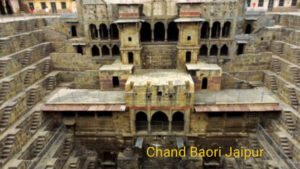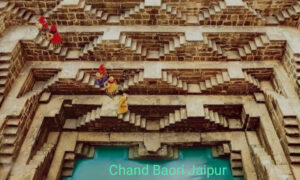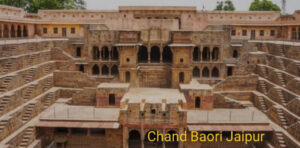When it comes to the architectural heritage of Rajasthan, one of the most intriguing structures is the Chand Baori jaipur . Located in the small village of Abhaneri, just a short drive from Jaipur, Chand Baori is one of India’s deepest and largest stepwells. This marvel of ancient engineering has stood the test of time, offering visitors a glimpse into the historical and cultural richness of the region. Whether you’re a history buff, an architecture enthusiast, or simply a curious traveler, Chand Baori is an unforgettable experience that showcases the ingenuity of India’s past.

1.Historical Background of Chand Baori jaipur
Chand Baori was constructed in the 9th century by King Chanda of the Nikumbh dynasty. The stepwell was primarily built for water conservation, a vital necessity in Rajasthan, where arid conditions and unpredictable rainfall have always been a challenge. Stepwells, or baoris, were ingenious solutions to store large amounts of water, ensuring a steady supply during the hot and dry months.
Beyond its practical purpose, Chand Baori also became a place of gathering, social interaction, and religious activity for the local community. The stepwell was situated close to the Harshat Mata Temple, dedicated to the goddess of joy and happiness. This connection between the two structures highlights the blend of utility and spirituality that defined the architectural style of ancient India. Chand Baori wasn’t just a source of water—it was a center of community life and religious devotion.
2.Architecture and Design of Chand Baori
Chand Baori is a testament to the sophisticated architectural prowess of ancient Indian builders. At 100 feet deep, it features 13 stories and is adorned with over 3,500 narrow steps that descend into the earth in a symmetrical, geometric pattern. The sheer scale of this stepwell is breathtaking, making it one of the largest and deepest in the world.
The unique design of Chand Baori serves more than just an aesthetic purpose. The steep, descending steps form a labyrinthine pattern, which creates an optical illusion when viewed from above, making the structure appear even more intricate. Moreover, the step well’s deep walls and steps help maintain a significantly cooler temperature at the bottom, a welcome respite from the harsh Rajasthan heat. Visitors will find that the bottom of the stepwell is often 5 to 6 degrees cooler than the surface, offering a perfect example of how the architecture was adapted to the environment.
The sheer depth and symmetry of Chand Baori make it not only a marvel of engineering but also a work of art. Its precision, geometric patterns, and craftsmanship are unmatched. As you descend into the stepwell, each level reveals more of its complexity, with each step meticulously designed to enhance both form and function.

3.Religious and Cultural Significance
Chand Baori proximity to the Harshat Mata Temple underscores its religious and cultural importance. Water has always held deep symbolic significance in Hinduism, representing purity, life, and spiritual rejuvenation. Stepwells like Chand Baori were often associated with religious rituals, and locals would use the water for temple offerings and other sacred practices.
The Harshat Mata Temple, although now in ruins, was once a grand structure that attracted pilgrims and worshippers from surrounding areas. During festivals and special occasions, the area around Chand Baori would come alive with celebrations, religious ceremonies, and community gatherings. Even today, the temple and the stepwell remain important landmarks in the spiritual landscape of Rajasthan.
4.Why Chand Baori is Famous
Although Chand Baori may not be as well-known as some of India’s other historical landmarks, it has earned international fame through popular culture. The stepwell has been featured in several films, including The Dark Knight Rises and the Bollywood movie Paheli. Its dramatic architecture and atmospheric appeal make it a perfect location for filmmakers looking to capture the essence of ancient India.
Apart from its cinematic fame, Chand Baori is a popular destination for tourists, photographers, and history enthusiasts alike. Its stunning geometry, historical significance, and serene environment make it a must-visit site for anyone traveling in Rajasthan. Despite being a lesser-known tourist attraction compared to Jaipur’s Amber Fort or Hawa Mahal, it remains one of the most extraordinary architectural treasures in the state.

6.Visiting Chand Baori
Chand Baori is located in the village of Abhaneri, about 95 kilometers from Jaipur, making it an easy day trip from the Pink City. The journey takes around two hours by car, and visitors can either hire a private taxi or use public transportation to reach the site.
The best time to visit Chand Baori is during the cooler months, from October to March, when the weather is pleasant and ideal for exploring outdoor attractions. Visitors can spend time marveling at the stepwell’s architecture, descending into its depths, and exploring the nearby Harshat Mata Temple.
Entry to Chand Baori is free, although it’s advisable to check the opening hours before planning your visit. The stepwell is open daily from morning until late afternoon. Visitors should be aware that there are no major facilities at the site, so it’s a good idea to bring water, sunscreen, and other essentials. As with many historical sites in India, respectful behavior and photography etiquette are encouraged.
7.Conservation and Preservation Efforts
Despite its enduring beauty, Chand Baori faces challenges in terms of conservation. The structure has weathered centuries of exposure to the elements, and environmental factors like erosion and the impact of tourism have taken their toll. Thankfully, efforts are being made by the Indian government, along with various NGOs, to preserve and restore Chand Baori to its former glory.
Conservation projects aim to ensure the structural stability of the stepwell while protecting its intricate carvings and steps. These efforts are crucial for maintaining this historical monument for future generations. As awareness grows about the significance of Chand Baori, it’s likely that continued efforts will be made to preserve this important piece of India’s heritage.
Conclusion:
Chand Baori is more than just a stepwell—it is a window into the past, a symbol of ancient ingenuity, and a reflection of the cultural and spiritual life of its time. Its unique architecture, historical importance, and serene beauty make it one of Rajasthan’s hidden gems. For travelers and history lovers alike, a visit to Chand Baori offers an unforgettable experience and a deeper appreciation of India’s architectural and cultural heritage.
If you find yourself in Jaipur, don’t miss the opportunity to step into the depths of history at Chand Baori – a true marvel of ancient India!
FAQ:
1.Chand Bawdi is in which district of Rajasthan?
2.Why is Chand Bavadi famous?
3.How many floors is there in Chand Bawdi?
4.Which is the biggest bavari of Rajasthan?
5.Chand baori jaipur wikipedia
6.Where is Chand Baori
7.Chand Baori ticket price
8.Where is Abhaneri Chand Bawdi located?
9.Chand Baori haunted story
10.Who made Chand Bavadi?

